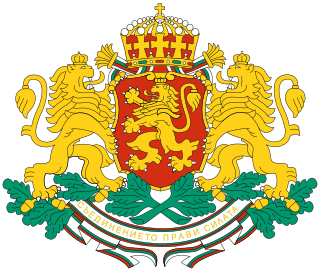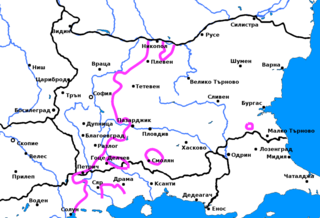
The South Slavic languages are one of three branches of the Slavic languages. There are approximately 30 million speakers, mainly in the Balkans. These are separated geographically from speakers of the other two Slavic branches by a belt of German, Hungarian and Romanian speakers. The first South Slavic language to be written was the variety of the Eastern South Slavic spoken in Thessaloniki, now called Old Church Slavonic, in the ninth century. It is retained as a liturgical language in Slavic Orthodox churches in the form of various local Church Slavonic traditions.

Shtokavian or Štokavian is the prestige dialect of the pluricentric Serbo-Croatian language and the basis of its Serbian, Croatian, Bosnian and Montenegrin standards. It is a part of the South Slavic dialect continuum. Its name comes from the form for the interrogatory pronoun for "what" in Western Shtokavian, što. This is in contrast to Kajkavian and Chakavian.

The History of the Bulgarian language can be divided into three major periods:

Torlakian, or Torlak is a group of South Slavic dialects of southeastern Serbia, Kosovo, northeastern North Macedonia, and northwestern Bulgaria. Torlakian, together with Bulgarian and Macedonian, falls into the Balkan Slavic linguistic area, which is part of the broader Balkan sprachbund. According to UNESCO's list of endangered languages, Torlakian is vulnerable.

The Northwestern Bulgarian dialects are two closely related dialects of the Bulgarian language, which are located west of the yat boundary and thus are part of the Western Bulgarian dialects. The range of the dialects includes most of northwestern Bulgaria, to the west of the line between Nikopol, Pleven and Mezdra and to the north of the line between Vratsa and Belogradchik. They bear strong resemblance to their neighbouring Eastern Bulgarian dialects and with some exceptions, mainly the pronunciation of yat, have the same phonological and morphological features as the neighbouring subdialects of the Eastern Bulgarian Central Balkan dialect.

The Byala Slatina-Pleven dialect is a Bulgarian dialect spoken in the regions of Pleven, Byala Slatina and Kula in northwestern Bulgaria. The dialect is part of the Northwestern Bulgarian dialects. The most significant feature of the dialect, as in all Western Bulgarian dialects, is the pronunciation of Old Church Slavonic ѣ (yat) only as instead of formal and Eastern Bulgarian я/е (~) – бел/бели instead of бял/бели. Otherwise, the Byala Slatina-Pleven dialect bears strong resemblance to its neighbouring Eastern Bulgarian dialects and with some exceptions, mainly the pronunciation of yat, has the same phonological and morphological features as the neighbouring subdialects of the Eastern Bulgarian Central Balkan dialect.

The Balkan dialects are the most extensive group of dialects of the Bulgarian language, covering almost half of the present-day territory of Bulgaria and slightly less than a third of the territory on the Balkans where Bulgarian is spoken. Their range includes north-central Bulgaria and most of the Bulgarian part of Thrace, excluding the Rhodopes, the region of Haskovo and Strandzha. As a result of the mass population movements that affected eastern Bulgaria during the 19th and the beginning of the 20th century, the Balkan dialects are now spoken also in vast areas of northeastern Bulgaria, especially the regions of Dobrich and Varna. The most significant feature of the dialects, as in most Eastern Bulgarian dialects, is the pronunciation of Old Church Slavonic ѣ (yat) as or, depending on the character of the following syllable. The Balkan dialects, and in particular, the Central Balkan dialect, lie at the foundation of formal Bulgarian. However, they are not identical to the standard language because many of its features derive from the Western Bulgarian dialects, including the Macedonian dialects, or are a compromise between Eastern and Western standard.

The Central Balkan dialect is a Bulgarian dialect that is part of the Balkan group of the Eastern Bulgarian dialects. Its range includes most of north-central Bulgaria, as well as the regions of Karlovo, Kazanlak and Plovdiv in southern Bulgaria, all the way down to the northernmost ridges of the Rhodopes. As a result of the mass population movements that affected eastern Bulgaria during the 19th and the beginning of the 20th century, the Central Balkan dialect is now spoken also in vast areas of northeastern Bulgaria. The most significant feature of the dialect is the pronunciation of Old Church Slavonic ѣ (yat) as or, depending on the character of the following syllable. The Central Balkan dialect lies at the foundation of formal Bulgarian. However, it is not identical to the standard language because many of its features derive from the Western Bulgarian dialects, including the Macedonian dialects, or are a compromise between Eastern and Western standard. The Central Balkan dialect includes a number of subdialects, e.g. Troyan, Lovech, Gabrovo, Karlovo, Kalofer, Tryavna, etc. which share many common features and yet have some differences.
The Erkech dialect is a Bulgarian dialect, which is part of the Balkan group of the Eastern Bulgarian dialects. It originates from two villages in the eastern parts of the Balkan Mountains, Kozichino near Pomorie and Golitsa south of Varna. As a result of the mass population movements that affected eastern Bulgaria during the 19th and the beginning of the 20th century, speakers of the dialect have established numerous colonies in the regions of Provadia, Varna, Novi Pazar, Balchik, Silistra and Pomorie, thus significantly expanding the range of the dialect. The most significant feature of the dialect, as in all Balkan dialects, is the pronunciation of Old Church Slavonic ѣ (yat) as or, depending on the character of the following syllable.

The Subbalkan dialect is a Bulgarian dialect, which is part of the Balkan group of the Eastern Bulgarian dialects. Its range includes the northeastern part of Bulgarian Thrace, i.e. the regions of Burgas, Sliven, Yambol, Stara Zagora and Chirpan. As a result of the mass population movements that affected eastern Bulgaria during the 19th and the beginning of the 20th century, speakers of the Subbalkan dialect have moved en masse to northeastern Bulgaria and now form a vast portion of the population of the districts of Varna, Dobrich and Balchik. Some of these also went as far as Bessarabia establishing numerous colonies there. Nowadays, a large part of the Bessarabian Bulgarians speak this dialect. The most significant feature of the Subbalkan dialect, as in all Balkan dialects, is the pronunciation of Old Church Slavonic ѣ (yat) as or, depending on the character of the following syllable.
The Pirdop dialect is a Bulgarian dialect, which is part of the Balkan group of the Eastern Bulgarian dialects. Its range includes the towns of Pirdop, Zlatitsa and Koprivshtitsa, as well as several neighbouring villages. The most significant feature of the dialect, as in all Balkan dialects, is the pronunciation of Old Church Slavonic ѣ (yat) as or, depending on the character of the following syllable. However, the Pirdop dialect also features a number of characteristics which bring it closer to the neighbouring Western Bulgarian dialects, and especially to the Botevgrad dialect and which, in turn, separate it from the rest of the Balkan dialects.
The Panagyurishte dialect is a Bulgarian dialect, which is part of the Balkan group of the Eastern Bulgarian dialects. Its range includes the town of Panagyurishte, as well as a number of neighbouring villages. The most significant feature of the dialect, as in all Balkan dialects, is the pronunciation of Old Church Slavonic ѣ (yat) as or, depending on the character of the following syllable.

The Rup dialects, or the Southeastern dialects, are a group of Bulgarian dialects located east of the yat boundary, thus being part of the Eastern Bulgarian dialects. The range of the Rup dialects includes the southern part of Thrace, i.e. Strandzha, the region of Haskovo, the Rhodopes and the eastern half of Pirin Macedonia.
The Strandzha dialect is a dialect of the Bulgarian language, member of the Rup or Southeastern Bulgarian dialects. The present range of the dialect includes the Bulgarian part of Strandzha. In the past, the dialect was spoken on a much larger territory and extended far down into Eastern Thrace, now in Turkey. Following the Balkan wars, the Bulgarian population there was forced to flee to Bulgaria, settling mostly in the regions of Burgas and Varna in eastern Bulgaria.
The Thracian dialect is a dialect of the Bulgarian language, member of the Rup or Southeastern Bulgarian dialects. The present range of the dialect includes the regions of Haskovo, Parvomay, Elhovo, Harmanli, Svilengrad, Topolovgrad and Ivaylovgrad. In the past, the dialect was spoken on a much larger territory and extended far down into Eastern and Western Thrace, now in Turkey and Greece, respectively. Following the Balkan wars, the Bulgarian population there was forced to flee to Bulgaria, settling mostly in the regions of Burgas and Haskovo, Yambol and Plovdiv.
The Smolyan dialect or Central Rhodope dialect is a Bulgarian dialect of the Rhodopean group of the Rup dialects. Its range includes most of the Central Rhodopes, i.e. the region of Smolyan. Its immediate neighbours are the Rhodopean Hvoyna dialect to the north, the Serres-Nevrokop dialect and the Razlog dialect to the west and the Turkish dialects of the Turkish population in the Eastern Rhodopes. To the south, the Smolyan dialect crosses the Greek-Bulgarian border and is spoken by much of the Muslim Bulgarian (Pomak) population in Western Thrace. As a result of the rugged mountainous terrain and the century-long isolation of the region from the rest of the country, the Smolyan dialect is the most idiosyncratic of all Bulgarian dialects and is not readily understandable even for its immediate neighbours.
The Teteven dialect is a Bulgarian dialect, which is part of the Balkan group of the Eastern Bulgarian dialects. It is spoken in the town of Teteven and several neighbouring villages and is almost completely surrounded by the Central Balkan dialect, except on the west where it borders on the Western Bulgarian Botevgrad dialect. The most significant feature of the dialect, as in all Balkan dialects, is the pronunciation of Old Church Slavonic ѣ (yat) as or, depending on the character of the following syllable.

Hungarian has ten dialects. These are, for the most part, mutually intelligible, and do not differ significantly from standard Hungarian. They are mostly distinguished by pronunciation; although there are differences in vocabulary, these are usually small and do not hinder intelligibility. Due to increased internal migration and urbanization during the 20th century, most of the characteristics of the different dialects can only be observed in smaller towns and villages, and even there mostly among the elderly; the population of the larger cities and especially the capital has been mixed for generations and the dialectal differences have been lost. A notable exception is the Western Transdanubian pronunciation, which is distinctly noticeable even in Szombathely, the largest city in the region.

The dialects of Serbo-Croatian include the vernacular forms of Serbo-Croatian as a whole or as part of its standard varieties: Bosnian, Croatian, Montenegrin and Serbian. They are part of the dialect continuum of South Slavic languages that joins the Macedonian dialects to the south, Bulgarian dialects to the southeast and Slovene dialects to the northwest.

The Lab Albanian dialect is a Tosk Albanian dialect associated with the wider definition of the ethnographic region of Labëria, spoken by Lab Albanians. Under this wider definition of Labëria, Lab Albanian stretches from Vlorë and Mallakastër south and east up to Gjirokastër, Lunxhëria and Sarandë. Notable aspects of Lab in Albanian and wider Balkan areal linguistics include its peculiar mix of conservative and innovative features, the lack of typical Albanian Balkanisms like the admirative, and the presence of features typical of Northern Gheg dialects despite it being a Southern dialect.